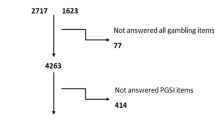Abstract
A sample of 93 veterans (92.4% males), with a median age of 41, (Mean=43.5) attending clinics for problem drinking, drug abuse and other mental disorders was screened for problems associated with the diagnosis of pathological gambling. The diagnostic instrument employed was the South Oaks Gambling Screen developed by Lesieur and Blume. The data replicate earlier findings indicating a link between parental problem gambling and pathological gambling. The results extended this association to include grandparents thus firming the familial relationship. Several epidemiological measures were defined and illustrated. These included relative risk, the odds ratio, attributable risk percent and population attributable risk percent. The data were consistent with previous research that substance abusers are about six times as likely to be addicted to gambling as the general population.
Similar content being viewed by others
References
Ahlbom, A. & Norell, S. (1990).Introduction to modern epidemiology. Chestnut Hill, MA: Epidemiology Resources Inc.
Ciarrocchi, J. (1987). Severity of impairment in dually addicted gamblers.Journal of Gambling Behavior, 3, 16–26.
Cole, P. & MacMahon, B. (1971). Attributable risk percent in case-control studies.British Journal of the Society of Preventive Medicine, 25, 242–244.
Cooke, D.J. (1987). The significance of life events as a cause of psychological and physical disorder. In B. Cooper (Ed.)The Epidemiology of Psychiatric Disorders, (pp. 67–80). Baltimore: John Hopkins University Press.
Cornfield, J. (1951). A method for estimating comparative rates from clinical data: Applications to cancer of the lung, breast, and cervix.Journal of the National Cancer Institute, 11, 1269–1275.
Fairburn, C.G. & Beglin, S.J. (1990). Studies of the epidemiology of bulimia nervosa.American Journal of Psychiatry, 147, 401–408.
Feinstein, A.R. (1985).Clinical epidemiology. The architecture of clinical research. Boston: Little, Brown and Co.
Goodwin, D.W. (1976).Is alcoholism hereditary? New York: Oxford University Press.
Gross, J. & McCaul, M.E. (1991). A comparison of drug use and adjustment in urban adolescent children of substance abusers.International Journal of the Addictions, 25 (4A), 495–511.
Jacobs, D.F. (1989a). Illegal and undocumented: A review of teenage gambling and the plight of problem gamblers in America. In H. Shaffer, S. Stein, B. Gambino, & T. Cummings (Eds.).Compulsive gambling: Theory, research and practice (pp. 249–292). Lexington, MA: Lexington Books.
Jacobs, D.F. (1989b). Children of problem gamblers.Journal of Gambling Behavior, 5, 261–268.
Kahn, H.A. & Sempos, C.T. (1989).Statistical Methods in Epidemiology. New York: Oxford University Press.
Kleinbaum, D.G., Kupper, L.L. & Morgenstern, H. (1982).Epidemiologic research. Belmont, Calif.: Lifetime Learning Publications.
Kramer, M.S. (1988).Clinical epidemiology and biostatistics. New York: Springer-Verlag.
Lesieur, H.R. & Blume, S.B. (1987). The South Oaks Gambling Screen (the SOGS): A new instrument for screening pathological gamblers.American Journal of Psychiatry, 144, 1184–1188.
Lesieur, H.R., Blume, S.B. & Zoppa, R.M. (1986). Alcoholism, drug abuse, and gambling.Alcoholism: Clinical and Experimental Research, 10, 33–38.
Lesieur, H.R. & Rothschild, J. (1989). Children of Gamblers Anonymous members.Journal of Gambling Behavior, 5, 269–281.
Mantel, N. & Haenszel, W. (1959). Statistical aspects of the analysis of data from retrospective studies of disease.Journal of the National Cancer Institute, 22, 719–748.
Miettinen, O.S. (1985).Theoretical epidemiology. Principles of occurrence research in medicine. New York: Wiley & Sons.
Miettinen, O.S. (1974). Proportion of disease caused or prevented by a given exposure, trait or intervention.American Journal of Epidemiology, 99, 325–332.
Rothman, K.J. (1986).Modern epidemiology. Boston: Little Brown.
Schlesselman, J.J. (1982).Case-control studies. New York: Oxford University Press.
Volberg, R.A. & Steadman, H.J. (1989). Policy implications of prevalence estimates of pathological gambling. In H.J. Shaffer, S. Stein, B. Gambino, & T.N. Cummings (Eds.)Compulsive gambling: Theory, research, and practice (pp. 163–174). Lexington, MA: D.C. Heath.
Volberg, R.A. & Steadman, H.J. (1988). Refining prevalence estimates of pathological gambling.American Journal of Psychiatry, 145, 502–505.
Author information
Authors and Affiliations
Additional information
This research was supported in part by a grant from the Massachusetts Department of Public Health.
Rights and permissions
About this article
Cite this article
Gambino, B., Fitzgerald, R., Shaffer, H. et al. Perceived family history of problem gambling and scores on SOGS. J Gambling Stud 9, 169–184 (1993). https://doi.org/10.1007/BF01014866
Issue Date:
DOI: https://doi.org/10.1007/BF01014866




